People Are Putting Deodorant All Over Their Bodies to Prevent Sweating—But Is It Safe?
We asked experts.
Sweating is uncontrollable one way or another. The main way to control excessive sweating is deodorant, but it's typically only used on our underarms. The issue? Our underarms aren't the only place on our bodies that produces sweat.
Enter the new group of people on TikTok who swear by applying deodorant all over their bodies. Yes, all over. From their thighs to the stomach and feet.
But is applying deodorant all over your body safe? We asked board-certified dermatologists Jaimie DeRosa, M.D., and Ramya Garlapati, M.D., FAAD, to share their insights on the trend.

mikroman6/Getty Images
How does deodorant prevent sweating?
There’s an important distinction here to note first: Deodorant itself actually doesn't stop sweating—it’s the antiperspirant that accomplishes this. “If you take a look at your deodorant, you’ll likely see ‘deodorant and antiperspirant’ written on the bottom. The deodorant part controls odors whereas the antiperspirant helps to stop sweating or to at least decrease its severity,” says Dr. DeRosa. An antiperspirant stops sweating by actually plugging up the sweat glands, which then signals your body to stop the flow of sweat.
Aluminum salts are the most common ingredients that, once dissolved, act to block the sweat glands. “The antiperspirant plug in the sweat gland dissipates over time, which is why you have to re-apply most deodorants every one to two days,” Dr. DeRosa explains. She shares that one trick to making sure your antiperspirant is as effective as it can be is to apply it at night to allow it to fully absorb, which takes about eight hours.
Does applying deodorant all over your body actually work?
While this seems…questionable, Dr. DeRosa says that using deodorant that has an antiperspirant on certain parts of the body can actually decrease sweating. “There are sweat glands in most parts of the body, with the most actually found on the feet, so you could use a deodorant or antiperspirant anywhere you’re bothered by excess sweating,” she shares.
Dr. Garlapti says it doesn't hurt to apply deodorant in areas where there is skin-to-skin contact. The antiperspirant will work by blocking the release of sweat from sweat glands, helping to control any excessive sweating you’re experiencing. This includes abdominal folds, your thighs, and under the breasts, as there is a higher likelihood of bacterial growth in these areas. “Applying it to these regions could also prevent irritation from friction of the two surfaces rubbing together,” she shares.
If you are interested in using deodorant on any part of your body besides your armpits, there are spray-on full body deodorants available that make application of the product to larger surfaces easier than a stick option. “Spray-on deodorants are also formulated with various scents, making them similar to applying a body spray or fragrance,” says Dr. Garlapti.
Is it safe to use deodorant all over your body?
In short, yes. “But you don’t really want to put deodorant all over your body at the same time,” says Dr. DeRosa. “We actually need to sweat to help control body heat, so if you’re blocking all of your sweat glands from working, you could, in theory, overheat,” she explains. Her recommendation is to target the most troublesome places that don’t get that much air (that’s what leads to odors) and allow for a little bit of sweat elsewhere. She also suggests doing a test patch before applying it all over your body to be sure your skin is not sensitive to the product. (Dr. DeRosa recommends using an unscented antiperspirant.)
In terms of safety, there seems to be chatter every several years about whether or not the aluminum salts found in deodorants are safe. “There is no good evidence that they cause breast cancer, but people with extremely weak kidney function may not be able to excrete the aluminum properly so they should avoid excess use,” says Dr. DeRosa.
Alternative options to deodorant
"If you’re looking to reduce sweat production and you experience sweating all over your body, I wouldn't recommend applying deodorant to your entire body as a long-term solution since this isn't going to decrease the sweat production,” says Dr. Garlapati. She recommends seeing a dermatologist to explore different prescription medication options to control the sweating, rather than relying on deodorant all over your body every time you work out.
Another great alternative to using a deodorant on your body is Botox and its neurotoxin counterparts such as Dysport, which can be injected superficially into the skin to prevent sweating whenever you’re bothered by excessive sweat. “The reason this treatment works is that, just like how Botox ‘freezes’ muscles on the face to smooth out wrinkles by blocking the neurotransmitter ACH that tells the muscles to contract, it prevents the same neurotransmitter from activating the sweat glands,” says Dr. DeRosa. It can take a week or two to notice a decrease in sweating, but the results will typically last for months, so repeat treatments are only needed every four months or so.
If you’re not interested in going the Botox route, Dr. Garlapati shares that there are other topical and oral prescription-strength medications available that can decrease and prevent sweating. These medications are a great option for those who experience sweating all over the body or have tried and failed different antiperspirants.
For more Real Simple news, make sure to sign up for our newsletter!
Read the original article on Real Simple.

